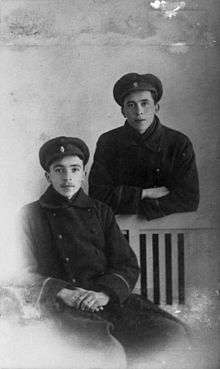Van Raemdonck Brothers


The Van Raemdonck brothers, Edward and Frans, were two soldiers from Temse in Flanders who served in the Belgian Army during World War I. They were both sergeants of the 6th company of the 24th Regiment of the Line (24. Linieregiment). Both were killed on the night of 25-26 March 1917 after an attack on the Stampkot at Steenstrate, the spot where a monument was erected for them later on. The brothers' death later became the subject of mythology in Flanders, particularly within the Flemish Movement. A monument was constructed out of concrete blocks that came from the Stampkot. The brothers are buried in the IJzertoren (the Yser Tower, named after the river Yser).
Flemish Movement
The dead bodies of both brothers were stored eighteen days after their death in an area which was plagued by shell bursts.
The proposal to ask for an armistice of half an hour in the area where the dead bodies were lying, in order to get them out of harm’s way and to bury them decently at Westvleteren had been rejected by General Louis Bernheim. To General Mahieu he apparently explained "I do not see the need. Moreover, it seems the younger of the two was a flamingant". Their corpses were destroyed by shellfire in September 1917 during a French attack.
Described as an example of heroism and brotherly love, the Van Raemdonck became a symbol of the Flemish Movement after the war and achieved mythical status. Flemish newspapers wrote compassionate articles on the subject for several weeks. They were drawn in pen by the artist Joe English.
Sources
- Shelby, Karen (2014). Flemish Nationalism and the Great War: The Politics of Memory, Visual Culture and Commemoration. London: Palgrave Macmillan. ISBN 9781137391735.
- De Ryck, Luc (1997). Terug naar niemandsland. De geschiedenis van de gebroeders Van Raemdonck: mythe en werkelijkheid. Koksijde: Klaproos.
- De Schaepdrijver, Karel; Charpentier, Julius (1918). Vlaanderens Weezang aan den IJzer. unknown.